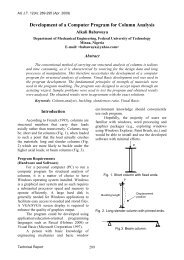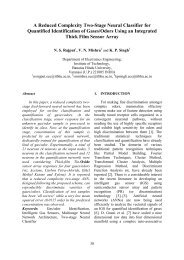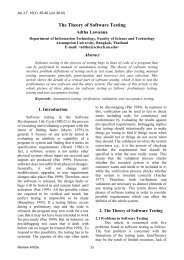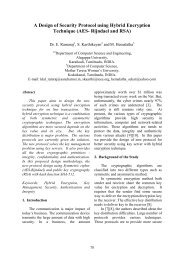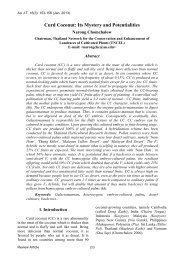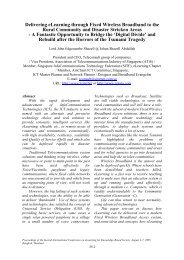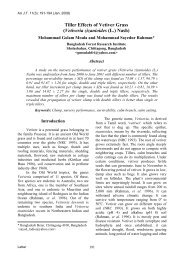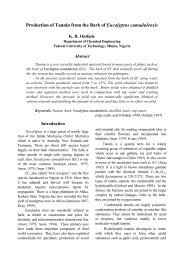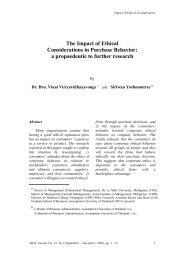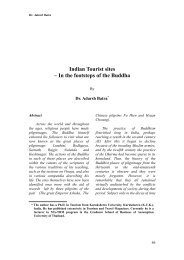Screening Antibiotics for the Elimination of Bacteria ... - AU Journal
Screening Antibiotics for the Elimination of Bacteria ... - AU Journal
Screening Antibiotics for the Elimination of Bacteria ... - AU Journal
Create successful ePaper yourself
Turn your PDF publications into a flip-book with our unique Google optimized e-Paper software.
<strong>AU</strong> J.T. 16(1): 7-18 (Jul. 2012)<br />
2.5 Minimum Bactericidal Concentration<br />
Determination (MBC)<br />
The various antibiotic concentrations<br />
selected from <strong>the</strong> antibiotic stability<br />
determination were used <strong>for</strong> this experiment.<br />
MBC determination was effectively done,<br />
using <strong>the</strong> broth dilution method. Antibioticcontaining<br />
broth <strong>of</strong> appropriate concentrations<br />
was inoculated with 1 ml <strong>of</strong> <strong>the</strong> corresponding<br />
bacterial suspensions and incubated <strong>for</strong> 18-24<br />
hours at 35-37 o C. Antibiotic-free broth<br />
inoculated with 1 ml <strong>of</strong> bacterial suspension<br />
served as a control <strong>for</strong> each <strong>of</strong> <strong>the</strong> isolates.<br />
After incubation, turbid broth in tubes<br />
indicated visible growth <strong>of</strong> microorganisms<br />
while non turbid broth showed no visible<br />
growth. The quantity, 0.1 ml <strong>of</strong> <strong>the</strong> non-turbid<br />
broth were inoculated onto a sterile Mueller-<br />
Hinton agar medium using a pour plate method<br />
and incubated <strong>for</strong> 18-24 hours to ascertain <strong>the</strong><br />
bactericidal effectiveness <strong>of</strong> <strong>the</strong> antibiotics.<br />
2.6 Statistical Analysis<br />
The final data are reported as <strong>the</strong> mean <strong>of</strong><br />
three replications <strong>for</strong> each antibiotic treatment.<br />
Statistical analysis <strong>of</strong> <strong>the</strong> data recorded from<br />
<strong>the</strong> experiment was per<strong>for</strong>med using <strong>the</strong><br />
analysis <strong>of</strong> variance (ANOVA) and P < 0·0001<br />
value was taken to indicate significance. All<br />
analyses were per<strong>for</strong>med in SAS (version 9.1,<br />
SAS Institute (2003), Cary, NC, USA) using<br />
<strong>the</strong> PROC GLM procedure.<br />
3. Results<br />
3.1 Evaluation <strong>of</strong> <strong>Antibiotics</strong> <strong>Screening</strong> on<br />
<strong>the</strong> <strong>Bacteria</strong>l Isolates<br />
Susceptibility test results <strong>for</strong> <strong>the</strong><br />
antibiotics were obtained from <strong>the</strong> data<br />
generated by <strong>the</strong> disc diffusion method. The<br />
disc diffusion method <strong>for</strong> antibacterial activity<br />
showed significant reduction in bacterial<br />
growth in terms <strong>of</strong> zones <strong>of</strong> inhibition around<br />
<strong>the</strong> discs. The mean <strong>of</strong> <strong>the</strong> growth inhibition<br />
zones <strong>of</strong> each <strong>of</strong> <strong>the</strong> bacteria at <strong>the</strong>ir different<br />
antibiotics (single and in combinations <strong>of</strong> two<br />
and five) concentration levels are shown in<br />
Tables 1 and 3. Results <strong>of</strong> <strong>the</strong> activities <strong>of</strong> <strong>the</strong><br />
single, combinations <strong>of</strong> two and five-antibiotics<br />
on each <strong>of</strong> <strong>the</strong> bacteria revealed that <strong>the</strong> zones<br />
<strong>of</strong> inhibition increased with increase in <strong>the</strong><br />
antibiotic concentrations, thus, exhibiting<br />
concentration dependent activity.<br />
3.2 Single <strong>Antibiotics</strong> Treatments<br />
The antibacterial activities and <strong>the</strong>ir<br />
corresponding MIC <strong>of</strong> <strong>the</strong> 11 selected<br />
antibiotics screened against Burkholderia spp.,<br />
Luteibacter rhizovicinus and Bacillus cereus<br />
are shown in Table 1. The antibiotic sensitivity<br />
tests revealed that all isolates were more<br />
sensitive to tetracycline, vancomycin,<br />
streptomycin, gentamycin and rifampicin (i.e.<br />
wider zones <strong>of</strong> inhibition and sensitive at lower<br />
antibiotics concentration (Table 3)). Among <strong>the</strong><br />
five most efficient antibiotics (tetracycline,<br />
vancomycin, streptomycin, gentamycin and<br />
rifampicin), gentamycin showed <strong>the</strong> largest<br />
zones <strong>of</strong> inhibition (18.5-25.2 mm) against <strong>the</strong><br />
three bacteria at higher concentrations (250-<br />
1,000 µg/ml) with no observed significant<br />
differences (P > 0.0001) between <strong>the</strong> <strong>Bacteria</strong><br />
strains. Results also showed that carbenicillin<br />
and trimetoprim showed no inhibitory effect<br />
against <strong>the</strong> three bacteria studied at all <strong>the</strong><br />
different levels <strong>of</strong> concentrations (3.0-1,000<br />
µg/ml). On <strong>the</strong> contrary, rifampicin presented<br />
growth inhibition zones at all <strong>the</strong> different<br />
concentration levels ranging from 9.7-22 mm<br />
while bacitracin, penicillin G, ampicillin and<br />
ce<strong>for</strong>taxime had poor activity with very small<br />
zones <strong>of</strong> inhibition (0-12 mm) which occurred<br />
only at <strong>the</strong> higher concentration levels (250-<br />
1,000 µg/ml). In general, <strong>the</strong> least inhibitory<br />
effect <strong>of</strong> <strong>the</strong> five effective antibiotics was<br />
found on Luteibacter rhizovicinus while<br />
Bacillus cereus and Burkholderia spp. were<br />
detected to be <strong>the</strong> most sensitive bacteria. No<br />
growth inhibition was observed in <strong>the</strong> control<br />
group.The variation in size <strong>of</strong> zones <strong>of</strong><br />
inhibition with different antibiotic<br />
concentrations was found to be statistically<br />
significant at most concentration.<br />
Research Paper 10



